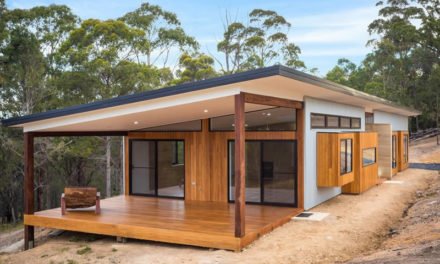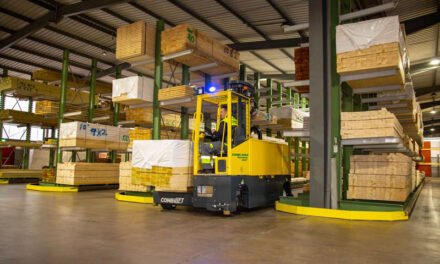A willingness to let customers guide direction and a passion for innovation powers Vekta.
Three things are essential for any truss manufacturer: accuracy, efficiency of plant operations, and quality of timber. Vekta Automation doesn’t go in for forest management, but they have the rest of the process covered.
As Vekta Automation Managing Director Ed Serrano says, “We specialise in offering automated solutions to truss plants, traditionally on the cutting and raw material handling side of the assembly process – though this is starting to change.”
Vekta first sold only the Razer saw – then an early version that was limited in what it could achieve. Working closely with industry, it has advanced the Razer considerably and added a set of reliable ancillary products that can be customised to meet user needs. Serrano says, “We have everything from manual infeed systems to fully automated, pack handling systems to feed the saws. The saws we offer are also highly configurable, in terms of layout and features. On the outfeed side, we have a range of options from manual systems to traditional ‘single station’ systems, right on through to large, multi-station and just in time solutions.”
A few years ago Vekta purchased the Stakpro product line for safer and more efficient truss and frame stacking. Recently this product line expanded to include the ‘Smart Conveyor’ roller line and ‘Truss Transfer’ system. “All three components work together to track and handle the finished product in a variety of modes,” says Serrano, “ensuring minimal human effort on the stacking side.”
Label it
One very popular addition to the Razer line has been the Vekta P3 printer, which prints at 300dpi in real time without the need to slow down the saw. It was developed in response to limitations of the old style of drop-on-demand printers, which cost a lot, were hard to repair, and didn’t even label well.
Vekta decided to invest in developing a new solution that exactly matched industry needs. “We became development partners with Hewlett Packard,” says Serrano, “enabling us to use their IP. It meant far more work in the short run, but in the end, we were left with a much better, far more expandable solution.
“The list of what we can print is now staggering – nail plates, stud, stud types, stud length, orientation marks, overhangs, noggin lengths, brackets, openings, logos, quality control checklists, truss-source information, junction marks…
“We can control the size, style and density of the font. We can customise even the component labels that are printed on each member. For example, we can print more information on larger members and less on short members, or we can say only print job numbers on bottom chords.”
It’s an easy-use system which is configured to site requirements and can be updated when they change. “The operator only needs to know how to replace the ink cartridges and how to wipe them clean with a damp rag,” says Serrano.
Sector-driven innovation
Automation has obvious benefits in terms of labour savings, but the optimisation systems included in Vekta products lead to timber savings as well, increasing profitability. Serrano adds, “Many of our customers also report that the printing technology is giving them a distinct advantage over their competitors. Clear, professional markings help eliminate costly mistakes on site and hence plants that can offer the builder ways to make their job easier are at an advantage.”
The company’s customers report a payback period of around two years, with most plants also seeing a notable increase in productivity after the installation of Vekta equipment.
Success has been largely driven by the company’s focus on listening to customers and potential customers and delivering what they wanted and needed. “I see Vekta as an enabler,” says Serrano. “The ideas for development almost always come from the industry. We simply find ways to make it happen and ensure that the solutions we put in the field work and are well supported. We don’t know what’s best for the industry, but we can see where the industry is trying to go and we contribute our know-how related to automated equipment to enable it to progress naturally. I’ve always said, we aim to act more in partnership with our customers than as simply a supplier.”
The introduction of the printer was one example of industry-led direction for the company, but its extensive customer service program is even more of a sector leader. “Service and support was always minimal in our industry,” says Serrano. “This started to compound as more high-tech equipment started to land in factories. We knew this was a critical area and so we started using modern approaches and the latest technologies for tech support. Today, I think we set the standard in service and support.”
Customer-focused support
Vekta operates a 24/7 support service that can be accessed by phone or internet. The machines can be logged into remotely and help is provided by staff in the appropriate time zone who are looking at details for the exact system – including customisations – the customer is using. In the case of a hardware issue, parts can be sent out same-day from extensive stock holdings for quick repair. With software issues, most can be sorted immediately
Most support tickets relate to training, as staff turnover can mean new operators have not received comprehensive training. Serrano says, “In most of these cases, we simply log into the saw and provide the additional training remotely.”
Issues are tracked and used to drive improvements to products and services, including mechanical design changes that are made available as upgrade kits for existing customers.
“With regard to intangible weaknesses such as poor on-training of new staff, we improve the self-diagnostics systems and we create better training material, including checklists and assessments, to help our customers with this issue,” says Serrano. “We have a full-time technical writer who works on our online help system, for example. The help system is fully integrated and is specifically designed to be used by a 15-year-old kid with no previous industry experience. We want to make sure that even the least-experienced staff members have the best possible chance of solving an issue themselves – the best outcome for all parties.
“This strong customer centric model acts as a catalyst for our development process. We listen to our customers’ frustrations and suggestions and then set out to find innovative solutions that can be applied to both our products and our services.”
Future innovations
Unsurprisingly, Vekta is investing heavily in the development of new products and features. Each design begins with industry needs and then looks for cost-effective solutions that will hold up to the rigours of truss manufacture. All products and enhancements are backwards compatible. Serrano says, “We want to make sure that as our products are improved, our existing customers’ systems are not going to become obsolete. Mechanical and software improvements are always available – it’s part of our business model.
“For a while now we have been working on a new saw specifically designed to be more cost effective for the smaller plants. We had a prototype last year, but it didn’t meet industry needs. Our new design is currently being built and is expected to be less maintenance intensive and more reliable. We are also in the process of building our new packfeeding system. The system will be able to support considerably more timber packs in a much smaller package – making it a realistic upgrade option for most plants. It will also support auto bow detection and flipping, as well as auto stacking. It will be retrofittable and can even be fitted to non-Vekta saws.”
New software is released every six to eight months. Serrano says, “The last release allows for the automatic docking of leftover timber to make it easier to use in our optimise-on-the-fly system, and production statistics being made available to any device on the site’s network – including mobile phones and tablets.
“The next version will include the ability to remotely monitor and interact with the saw. This feature will allow a single operator to go out into the yard, say to get timber for the next job. If the saw stops, the operator can be notified on a mobile or a tablet and can respond accordingly – hitting OK on the mobile device to let cutting continue or halting the saw until they can go back in to resolve the issue. This will make life easier for single-operator plants.
“We’re really excited about the things to come in 2018!”
For more information, visit vekta.com.au











